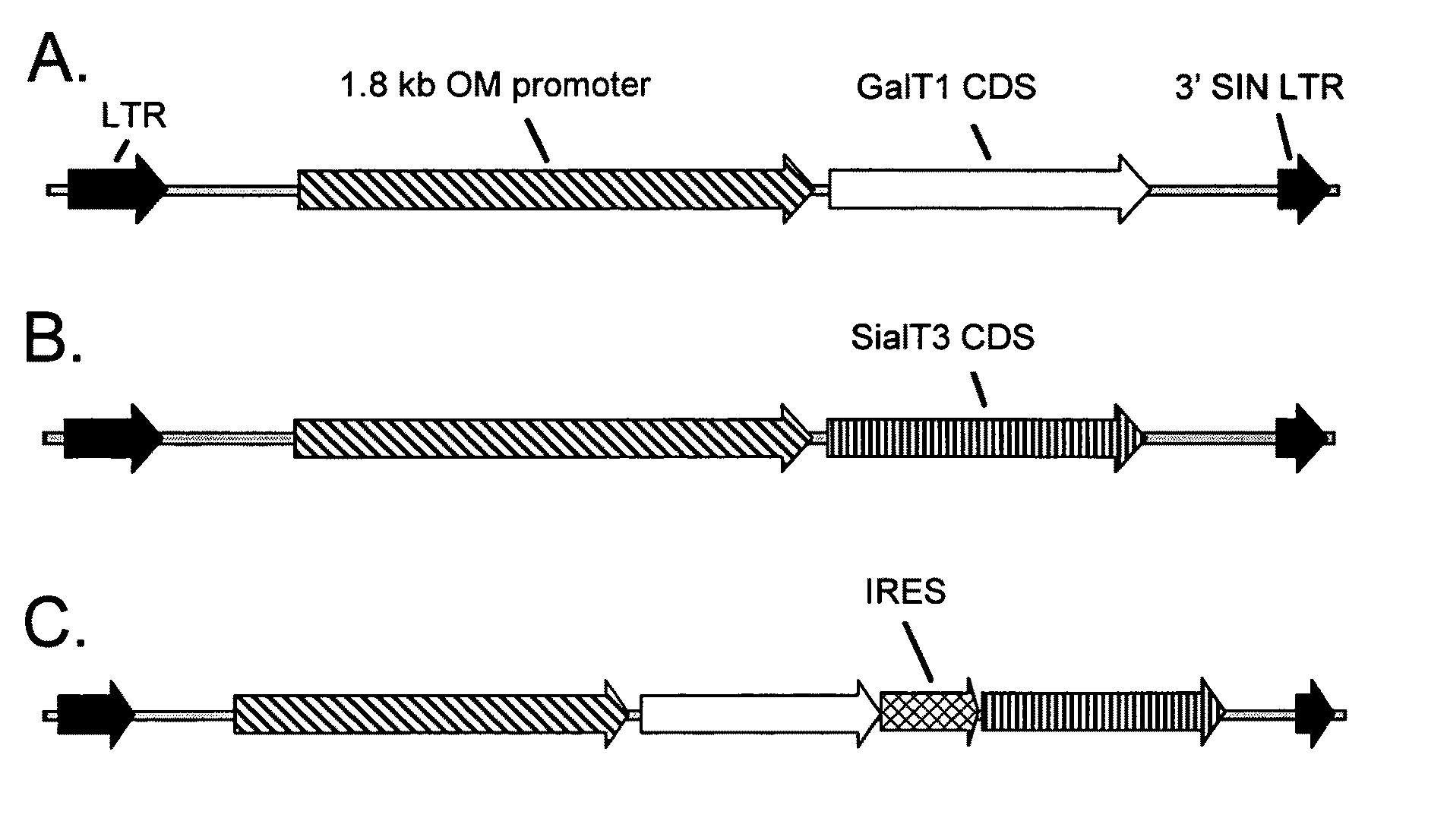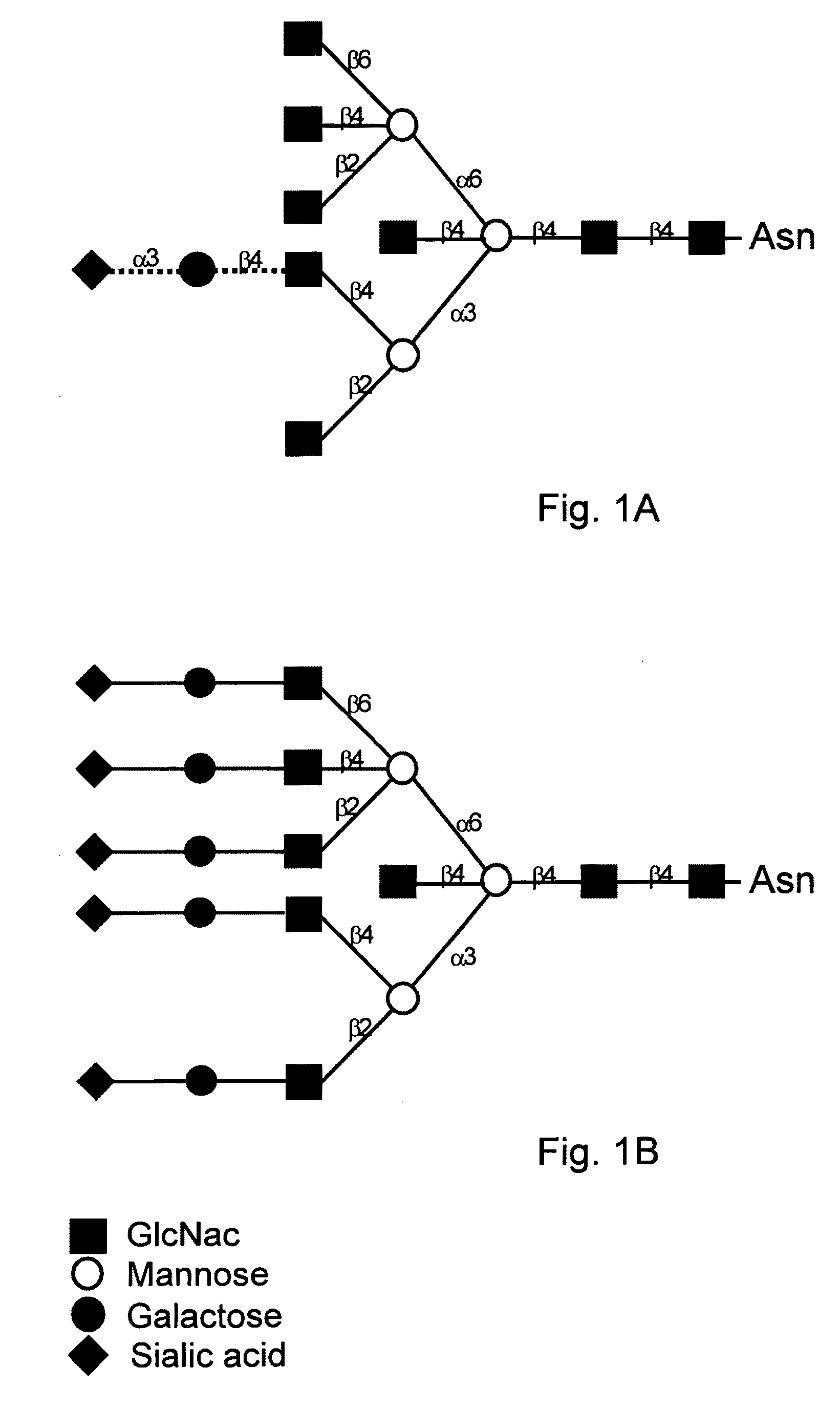Glycosylation in avians
a technology of glycosylation and avian, which is applied in the field of glycosylation in avians, can solve the problems of reducing efficacy, requiring immense resources to propagate at the scale needed, and difficult growth of mammalian cells under gmp conditions,
- Summary
- Abstract
- Description
- Claims
- Application Information
AI Technical Summary
Benefits of technology
Problems solved by technology
Method used
Image
Examples
example 1
Vector Design and Construction for Expression of GalT1 in the Avian Oviduct
[0180]The GalT1 coding sequence was synthesized by Integrated DNA Technologies (Coralville, Iowa) with codon usage optimized for expression in the hen magnum and is shown below (SEQ ID NO: 40):
ATGAAAGAACCTGCACTTCCTGGTACTTCACTGCAAAGAGCATGTAGACTGCTGGTAGCATTTTGCGCCCTGCACCTGAGCGCAACCCTGCTCTACTACCTGGCTGGATCCAGCCTGACTCCACCCCGCTCTCCAGAACCTCCCCCTCGGAGGCCGCCTCCAGCCAACCTCTCCCTGCCACCCTCCCGGCCTCCTCCTCCCCCTGCGGCTCGCCCCCGCCCAGGACCTGTTTCTGCACAACCCCGGAACCTGCCAGATTCTGCACCATCTGGACTGTGCCCCGATCCAAGTCCACTGCTCGTTGGTCCTCTGCGGGTGGAGTTTAGTCAGCCAGTGAACCTGGAGGAAGTGGCTTCTACCAATCCGGAGGTCAGGGAAGGAGGGAGATTCGCCCCAAAGGACTGCAAAGCGCTCCAGAAGGTGGCTATTATTATCCCCTTCAGGAACAGAGAGGAGCACCTGAAGTATTGGCTGTACTACATGCACCCGATTCTTCAGAGACAGCAATTGGACTATGGGGTCTATGTGATTAATCAAGACGGCGATGAAGAATTTAACAGAGCTAAACTGCTTAATGTCGGTTTCACTGAGGCACTCAAGGAATACGATTATGATTGCTTTGTGTTTTCCGATGTGGATCTGATTCCTATGGACGACCGTAACACATATAAGTGCTATAGTCAACCACGTCACCTGAGTGTGTCAATGGACAAGTTTGGCTTTAGGCTG...
example 2
Production of GalT1 Transgene Augmented Birds
[0184]The pALV-SIN-GalT1 vector produced as described in Example 1 was packaged into viral particles by the transient transfection method as disclosed in US patent publication No. 2007 / 0077650, published Apr. 5, 2007.
[0185]Virus-containing media was collected 48 hr post-transfection and concentrated by centrifugation and immediately injected into stage X embryos of windowed eggs (stage X is an approximately 50,000 cell embryo, typically found in a freshly laid egg).
[0186]Approximately 150 embryos were injected. The eggs were sealed with a hot glue plug and incubated (Andacht, et al. Mol Reprod Dev 69: 31-4, 2004). 42 chicks hatched about 21 days later and the blood DNA was assessed for the presence of the transgene one week later. The hatched chicks are designated G0 for generation zero.
[0187]To assess the success of the transgenesis procedure, a Taqman® quantitative PCR system was used to determine transgene content in the blood DNA of h...
example 3
Production of Fully Transgenic GalT1 Birds And Assessment of Transgene-Augmented Glycosylation
[0189]Semen was collected from G0 roosters of Example 2 and sperm DNA was analyzed by the Taqman assay for transgene content (Harvey, Speksnijder, Baugh, Morris and Ivarie. Poultry Science 81: 202-12, 2002). Roosters with the highest transgene content were bred to wild-type hens and offspring were analyzed by Taqman to identify fully transgenic G1s.
[0190]Eggs were collected from 13 G1 hens. Egg white proteins were treated with PNGase which specifically releases N-linked oligosaccharides (N-glycans) from proteins. The N-glycans were purified and structures were determined by MALDI-MS analysis, the results of which are shown in FIG. 8. As can be seen, the results demonstrate the effectiveness of the invention with a substantial amount of galactose being added to many of the oligosaccharide structures. In addition, FIGS. 8A-8C shows that more sialic acid has been added to the oligosaccharide ...
PUM
| Property | Measurement | Unit |
|---|---|---|
| Therapeutic | aaaaa | aaaaa |
Abstract
Description
Claims
Application Information
 Login to View More
Login to View More - R&D
- Intellectual Property
- Life Sciences
- Materials
- Tech Scout
- Unparalleled Data Quality
- Higher Quality Content
- 60% Fewer Hallucinations
Browse by: Latest US Patents, China's latest patents, Technical Efficacy Thesaurus, Application Domain, Technology Topic, Popular Technical Reports.
© 2025 PatSnap. All rights reserved.Legal|Privacy policy|Modern Slavery Act Transparency Statement|Sitemap|About US| Contact US: help@patsnap.com



